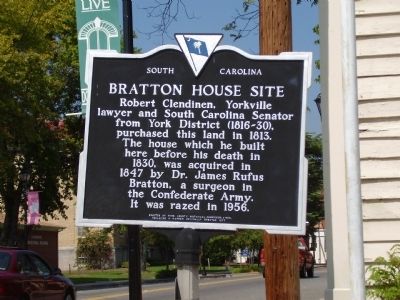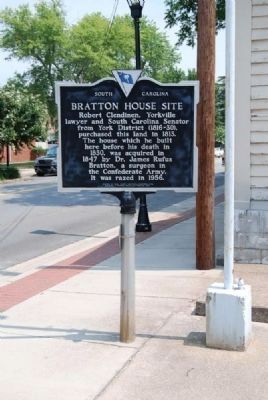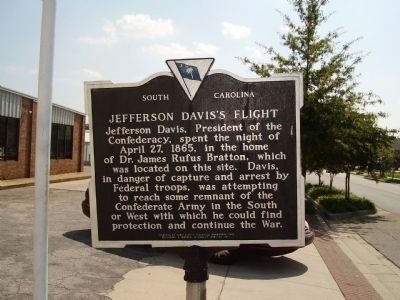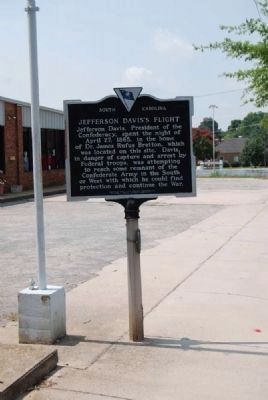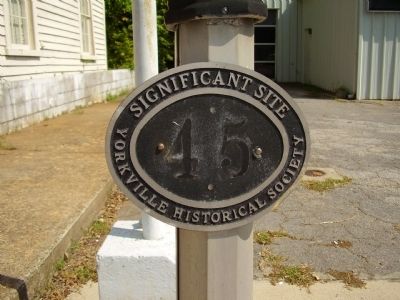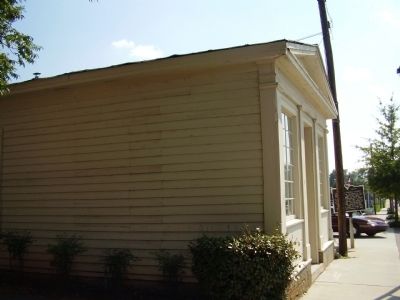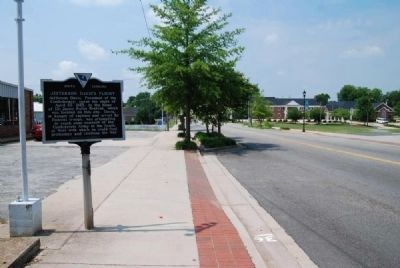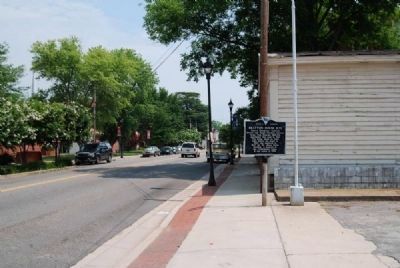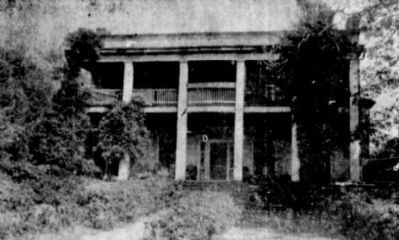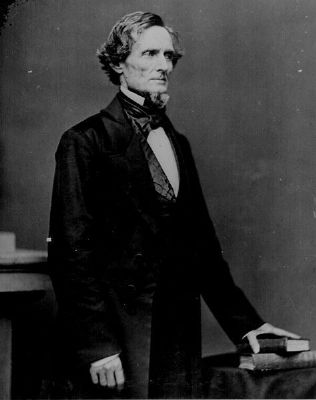York in York County, South Carolina — The American South (South Atlantic)
Bratton House Site / Jefferson Davis's Flight
Erected 1977 by York County Historical Commission. (Marker Number 46-11.)
Topics and series. This historical marker is listed in this topic list: War, US Civil. In addition, it is included in the South Carolina, York County Historical Commission series list. A significant historical date for this entry is April 27, 1781.
Location. 34° 59.607′ N, 81° 14.541′ W. Marker is in York, South Carolina, in York County. Marker is on South Congress Street (U.S. 321), on the right when traveling north. Touch for map. Marker is at or near this postal address: 47 South Congress Street, York SC 29745, United States of America. Touch for directions.
Other nearby markers. At least 10 other markers are within walking distance of this marker. York County Courthouses (within shouting distance of this marker); York County Courthouse (within shouting distance of this marker); Historic York (within shouting distance of this marker); First Presbyterian Church (about 400 feet away, measured in a direct line); Trinity M. E. Church, South (about 500 feet away); York County Veterans Memorial (about 700 feet away); Barnett Brothers Circus, 1929 ~ 1945 / Bennett Brothers Circus, 1929 ~ 1938 (about 700 feet away); Town of Yorkville / Town of York (approx. 0.2 miles away); Historic York, S.C. (approx. ¼ mile away); York County Confederate Monument (approx. 0.4 miles away). Touch for a list and map of all markers in York.
Related markers. Click here for a list of markers that are related to this marker. These markers trace Davis' flight into Georgia and his subsequent arrest.
Also see . . . Jefferson Davis. Wikipedia entry (Submitted on February 2, 2010, by Brian Scott of Anderson, South Carolina.)
Additional commentary.
1. Dr. James Rufus Bratton
Some Brattons, including John Simpson Bratton Jr. and Dr. James Rufus Bratton, resisted the efforts of African Americans to assert their equality. Rufus was especially active in the Ku Klux Klan and he fled to Canada for a while due to his involvement in the murder of Jim (Rainey) Williams, a local African American militia officer. (Source: http://chmuseums.org/brattonsville/aa_history.php.)
Various accounts, as well as family tradition, say that James Rufus Bratton of Yorkville was a leader in the Ku Klux Klan and fled to Canada to escape arrest by federal officers. Though holding a leadership role in the clandestine organization, he superficially gave the impression of abhorring violence and frowning on the activities of the Klan...Dr. Bratton's Klan activities were purportedly the subject of Thomas Dixon, Jr.'s novel The Clansman, which served as the basis for the movie, The Birth of a Nation. The author was reared in North Carolina. Dixon had relatives in York, whom he frequently visited, and probably heard family stories about the Klan. (Source: The Reconstruction Ku Klux Klan in York County, South Carolina, 1865-1877 by Jerry Lee West (2002), pgs 126, 130.)
— Submitted February 2, 2010, by Brian Scott of Anderson, South Carolina.
2. The Lynching of Jim (Rainey) Williams
On the evening of March 6, 1871, approximately seventy white men assembled on horseback at the Briar Patch muster ground on Howell Mill Road five miles west of Yorkville. Forty-nine-year-old James Rufus Bratton, a prominent York County physician, was the acknowledged mob leader. After donning robes and crude disguises to obscure their faces and adorning their horses with clean white sheets, the men set out to visit Williams and his militiamen. On this night, they would demonstrate the fearsome power of the Ku Klux Klan...
Galloping along familiar country roads, the gang stopped at freedmen's homes to whip suspected militiamen as a chilling prelude to the night's main event. They grew increasingly intoxicated with the power wielded by a mob and, perhaps, the spirits poured from a bottle. Traipsing through the countryside past McConnellsville, the men his in shadows until they approached a blind road leading to the Williams homestead. When they were three hundred yards away, Bratton ordered a dozen fellows to join him in reconnoitering the property. All was quiet. satisfied that no outsiders would interfere with their scheme, the small group marched across the yard, bounded to the steps, and slammed their fists and rifle butts against the front door.
Rose Williams, Jim's wife, answered. When the Klansmen demanded to know where Jim was, she said he was not there. They forced their way inside and encountered another freedman on the premises, but Jim Williams was nowhere to be found. According to M.S. Carroll, a Klansman who subsequently wrote of the event in his journal, the affair might have ended there had Bratton not see through Rose Williams's ruse. "After a moment's reflection," Carroll recalled, "Dr. Bratton told someone to pull up some of the plank flooring. 'He might be under there,' he said. And sure enough, there was Jim crouching down under the floor."
Gone was the freedman's braggadocio. In its place was naked fear, for Jim Williams knew what this band proposed to do. Even as he pleaded for mercy, the men fell upon him, jerking him up from the planking and hauled him outside. Someone, probably Bratton, placed a rope around his neck. The big man flailed his arms and legs, screaming and crying as if to raise an alarm. Behind him, Rose and the other black man also screaming, but to no avail.
The Klan would not be dissuaded from its work this night. If white Southerners were to reestablish home rule, black radicals would have to learn their place. The mob dragged Williams toward the horses. in Carroll's words, "someone spied a large tree with a limb running out 10 or 12 feet from the ground and suggested that that was the place to finish the job."
They tied the rope around Williams's neck to the tree limb and forced him to climb onto another limb. There he stood, precariously perched on a ledge. Someone ordered Williams to jump, but he refused. Bob Cladwell, another Klansman who later recorded the nights activities, climbed up next to the captain and tried to push the frightened men. When Williams grabbed the limb with his hands, Caldwell used a knife to hack at the men's fingers until he released his grip, at which time he "died cursing, pleading and praying all in one breath." After Williams was dead, the Klansmen hung a sign around his neck that read "Jim Williams on his big muster." (Source: Carpetbaggers, Cavalry, and the Ku Klux Klan: Exposing the Invisible Empire During Reconstruction by James Michael Martinez (2007), pgs 2-4.)
— Submitted February 2, 2010, by Brian Scott of Anderson, South Carolina.
3. Stately Old Bratton Home In York Was Built More Than 100 Years Ago
The Rock Hill Herald
September 20, 1948
by Elizabeth Reed
For more than a century the name of Bratton has been associated with the building of enduring homes and with the giving of its sons to the medical profession.
The beautiful columned Bratton home on South Congress street in York was bought in 1845 by Dr. J. Rufus Bratton, whose grandson and namesake now practices in Rock Hill.
The exact date of the building of the home is not known, but the builder was a Mr. Clendenning, probably now buried in Bethesda cemetery. Mr. Clendenning sold the home to Dr. E.A. Cranshaw who sold it in 1845 to Dr. Bratton.
Davis Slept Here
Of all the historic facts associated with the time the visit of Jefferson Davis is the most important. Confederate President Davis and his staff were guests in the home on the night of April 28, 1865 en route from Charlotte to Georgia. This was shortly after the Confederacy had fallen and some of his friends spoke of the loyal physician regarding the safety of entertaining the fallen president. He responded briskly that he had risked his life for four years in his country's cause on the battlefield and stood willing to risk his life and property in his country's cause.
With Davis on the eventful night were Secretary of War Breckenridge, Secretary of State Judah Benjamin and others.
York citizens were given the opportunity to greet their former leader that night when Dr. Bratton held a reception in honor of his famous guest. Davis refused to make a speech, but women and children gathered around him, so the story goes, kissing his hand and saying "You are my President."
Following the reception, Old Pete, the Bratton family butler, was sent to the President's room with a waiter holding priceless decanters of wine and whiskey. Old Pete evidently slipped among the stairs, because as he opened the door of Mr. Davis'
room he fell sprawling on the floor.
Late that night a knock was heard on the door of Mrs. William Hackett, whose home was opposite the Bratton house. Again it was Old Pete. "Marse Rufus done sent me to ask you to send him a nightshirt for Marse President, Jefferson Davis." So Pete recrossed the street carrying the long white nightshirt which had belonged to William Hackett, who had been killed in the Battle of the Crater at Petersburg, Va.
Davis spent the night in a huge four poster bed in the upstairs bedroom over the drawing-room (the room on the left of the hall).
Mrs. R.M. Bratton of York has a wealth of information about the house. She remembers the home as it looked when she was a girl and has a picture showing the front very much as it looks today -- but in much better condition.
The same long walk leads to the columned double porch. The front door is one of the fine features of the home and is surrounded with glass panels at sides and top. The porches, door and hall with stairway leading to the upper floor, are still very much the same as when built.
Mrs. Bratton remembers the large living room to the right where Dr. Bratton's desk sat. His office, however, was in a small building near the street.
On the left of the hall, was the drawing room with its mahogany furniture upholstered in black mohair. The large marble-topped
center table is still in the Bratton family as are most of the other articles of furnishing.
The long wide windows of the drawing room were hung with embroidered net curtains and with full side draperies of old blue damask. At the top of each window was a heavy gilt cornice.
The walls of the home were hung with handsome family portraits in the style of the time. The dining room was entered from the back porch.
The Bratton home was occupied continuously by members of the Bratton family from 1845, when purchased by Dr. Rufus Bratton, until 1944.
After the death of Dr. Rufus Bratton, his son and successor as York's physician, Dr. J. Andral Bratton with his wife and three children lived in the home. After the death of Dr. Andral Bratton, his daughter, Mrs. John Spratt, lived in the home until about 1944. It is still owned by the Bratton family.
— Submitted February 2, 2010, by Brian Scott of Anderson, South Carolina.
Credits. This page was last revised on February 12, 2023. It was originally submitted on September 6, 2008, by Stanley and Terrie Howard of Greer, South Carolina. This page has been viewed 7,420 times since then and 76 times this year. Last updated on September 8, 2008, by Brian Scott of Anderson, South Carolina. Photos: 1. submitted on September 6, 2008, by Stanley and Terrie Howard of Greer, South Carolina. 2. submitted on July 6, 2011, by Brian Scott of Anderson, South Carolina. 3. submitted on September 6, 2008, by Stanley and Terrie Howard of Greer, South Carolina. 4. submitted on July 6, 2011, by Brian Scott of Anderson, South Carolina. 5, 6. submitted on September 6, 2008, by Stanley and Terrie Howard of Greer, South Carolina. 7, 8. submitted on July 6, 2011, by Brian Scott of Anderson, South Carolina. 9. submitted on February 2, 2010, by Brian Scott of Anderson, South Carolina. 10. submitted on November 14, 2008, by Brian Scott of Anderson, South Carolina. • Craig Swain was the editor who published this page.
